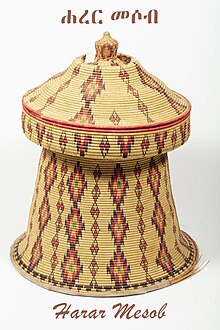Mesob (Amharic: መሶብ) or Harar Mesob is a Harari basket used for storing injera, an Ethiopian and Eritrean flatbread.[1][2] It is widely depicted as a cultural symbol for Ethiopia, made from locally grown and partially dyed grass and palm leaves known for strength and durability.[3][4]

History
editIn a certain form Mesob was identified in Abyssinia as early as the sixteenth century as reported by Portuguese explorer Francisco Álvares however the most prominent Mesob is of Harar origin.[5] In the mid 1970s Amharas began recruiting Harari artisans to develop a particular Mesob which incorporated Abyssinian and Harari designs, this variety would dominate Mesob productions in Ethiopia.[6]
In popular culture
editAlthough generally described as Ethiopian, mesob baskets belong to a larger tradition of Harari basketry. A mesob is depicted on the 10 birr note. Mesob baskets are used in funeral ceremonies to support family of the deceased person and the baskets are widely viewed as a symbolical representation of Ethiopian and Eritrean culture and their cuisine.[4]The Harar mesob is known to be a quality mesob with very complex and prized designs. Today, it is very rare to find old original Harari mesobs, because peoples are making more simplified and lower quality Ethiopian models.
References
edit- ^ Shinn, David (29 March 2004). Historical Dictionary of Ethiopia. Scarecrow Press. p. 198. ISBN 9780810865662.
- ^ Berg, Elizabeth (2000). Ethiopia. G. Stevens. p. 33. ISBN 9780836823240.
- ^ "Traditional Injera Mesob Ethiopian Eritrean Household - The Habesha Web". Retrieved 2022-09-13.
- ^ a b Neela, Satheesh; Fanta, Solomon Workneh (13 September 2022). "Injera (An Ethnic, Traditional Staple Food of Ethiopia): A review on Traditional Practice to Scientific Developments" (PDF). Journal of Ethnic Foods. 7. doi:10.1186/s42779-020-00069-x. S2CID 221824144.
- ^ Basketry. Encyclopedia Aethiopica.
- ^ Tarsitani, Belle. Revered vessels: custom and innovation in Harari basketry. MIT Press Journals. p. 73.